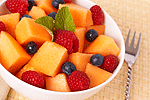 It’s summertime and nothing goes better with a hot day than a fresh fruit salad. And nothing is likely to be as nutritious either. This has got to the best health advice around: eat more fruit. Natural health begins with a variety of fruit. Here, we’ll head to the popular and easy-to-find fruits and create you a color-coded fruit salad that will knock your socks off. It’s powerfully healthy.
It’s summertime and nothing goes better with a hot day than a fresh fruit salad. And nothing is likely to be as nutritious either. This has got to the best health advice around: eat more fruit. Natural health begins with a variety of fruit. Here, we’ll head to the popular and easy-to-find fruits and create you a color-coded fruit salad that will knock your socks off. It’s powerfully healthy.
1. Blue
Blueberries contain heaping amounts of vitamin C, manganese, dietary fiber, vitamin E, and riboflavin. They are devastatingly nutritious. They have proven health benefits, and are some of the most potent antioxidants around because they are so small. Phytonutrients inside them are believed to help prevent heart disease, cancer, dementia, cataracts and glaucoma, ulcers, hemorrhoids, and varicose veins.
2. Red
Strawberries pack more vitamin C than oranges do; thus they are strong antioxidants. They are famous for two phenols, ingredients that give them a deep red color and simultaneously help protect against free radical damage. Strawberries have been linked to a decreased number of cancer deaths. These phenols could help protect the heart and prevent cancer and each can act as an anti-inflammatory. The fruit has nearly 20 different nutrients.
3. Crimson
Raspberries are the final piece of the berry puzzle. They are super-rich in tannins, ellagic acid, and flavonoids. Research suggests they could fight and prevent cancer. A cup of raspberries in your salad will give you half the daily requirements of fiber, vitamin C, and the mineral manganese. They have lots of other nutrients and could keep cholesterol down and keep blood sugar levels in check. No fruit salad starts more powerfully than that made with these three berries.
4. Peach
I’m not talking about peaches, but instead cantaloupe. It carries an excellent supply of beta-carotene, potassium and, yes, vitamin C. Let’s toss in, for good measure, vitamins B6, B1, B5, and B3, folate, and fiber. Cantaloupe is a great energy producer, while helping control carbs and blood sugar levels. One entire cup has just 60 calories, if you are counting.
5. Yellow
Yellow on the outside, but with pinky-orange flesh on the inside, Papaya is an amazing tropical addition to your salad, built for optimal (and easily obtained) nutrition. It contains papain, an enzyme that soothes the stomach and could relieve ulcers, indigestion, bloating, inflammation and fever. It’s also believed to play a role in combating joint pain, diabetes and a sluggish immune system. Papayas have tons of vitamin C, carotenes and flavonoids, and fiber, several B vitamins, and potassium and magnesium.
6. Orange
Orange can only mean one thing: oranges. Even without its vitamin C levels, the orange is a major antioxidant: it contains a bunch of citrus polyphenols. One ingredient, hesperidin, may reduce cholesterol and blood pressure. The World Health Organization says that a diet high in citrus fruits plays a role in preventing chronic illnesses from setting in, not the least of which being cardiovascular disease.
7. Pink
The seventh ingredient is our friendly everyday watermelon. Its flesh contains nine essential nutrients — high in vitamins A and C — and lycopene. That’s the ingredient that makes tomatoes protective against heart disease and cancers. It’s 92% water, too.
8. Green
Lastly, slice up some chunks of kiwi. Tons of vitamin C, and, along with hefty serving of fiber, this tasty salad addition has lots of magnesium, potassium, copper, phosphorus, vitamin E, vitamin A, and riboflavin. It is another active disease-blocking fruit, and may play a specific role in preventing respiratory conditions such as asthma.
